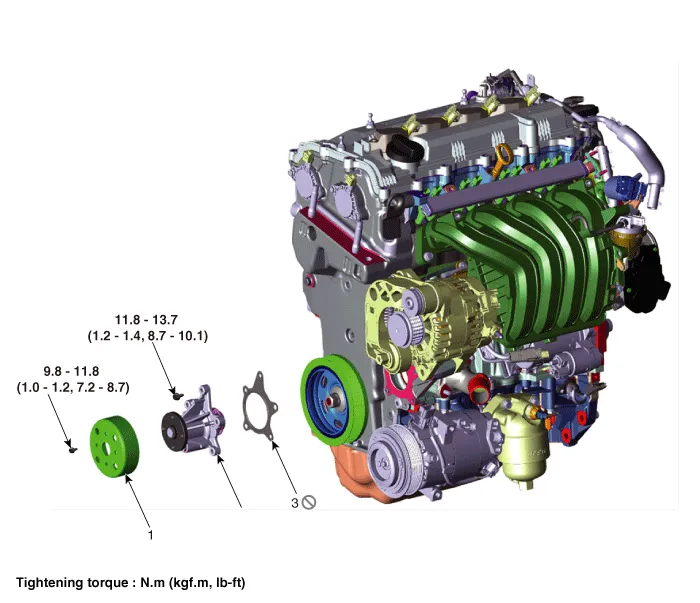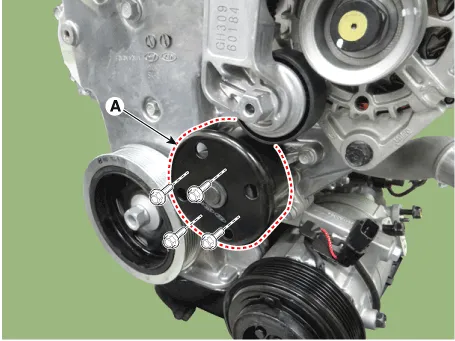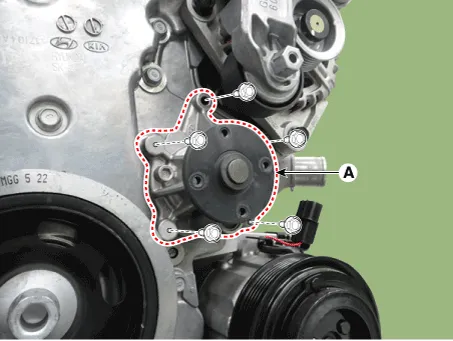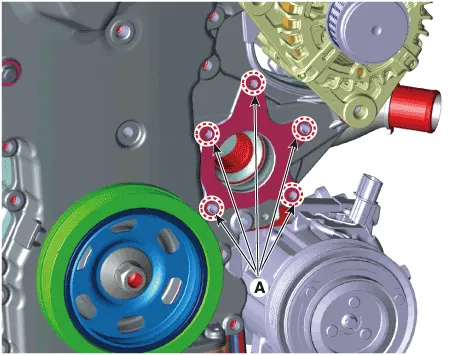Hyundai Accent (HC): Cooling System / Water pump

1. Water pump pulley
2. Water pump
3. Water pump gasket
1.Remove the engine room under cover.(Refer to Engine and Transaxle Assembly - "Engine Room Under Cover")
2.Drain the coolant. (Refer to Cooling System - "Coolant")
3.Remove the drive belt. (Refer to Timing System - "Drive Belt")
4.Remove the water pump pulley (A).
Tightening torque :9.8 - 11.8 N.m (1.0 - 1.2 kgf.m, 7.2 - 8.7 lb-ft)

5.Remove the water pump (A) and gasket.
Tightening torque :11.8 - 13.7 N.m (1.2 - 1.4 kgf.m, 8.7 - 10.1 lb-ft)

6.Install in the reverse order of removal.

• Always use new water pump gasket.
• Check the specifications of the water pump instaling bolts. (Make sure that a solid sealant is applied to the thread of the bolt.)
• Always use new water pump bolts.
• Remove the sealant residue inside the bolt tap hole.
• When installing the water pump, tighten the bolts in the order shown in the figure below.

• Before installing the water pump, remove the hardened sealant, foreign matters, oil, dust, water, etc. off the inside hole (A) where the bolt is installed.

7.Fill with engine coolant. (Refer to Cooling System - "Coolant")

• The coolant must be injected according to the integrated thermal management module (ITM) coolant filling method.
8.Start engine and check for leaks.
| Trouble Symptom | Probable Cause | Remedy | ||||||||
| Coolant leakage |
| Visually check |
|
| ||||||
| ||||||||||
| ||||||||||
• From gaskets or bolts
• Check the tightening of the water pump mounting bolts.
• Retighten the mounting bolts.
• Check damage of gaskets or inflow of dust.
• Replace the gasket and clean dust off.
• From outer surface of water pump
• Check the material or any cracks of the water pump.
• Poor material. If any crack found, replace the water pump.
Noise
• From bearings
• From mechanical seals
• Impeller interference
Inspection with a stethoscope• After starting the engine, check noise with a stethoscope.
• If there is no noise, reuse the water pump (do not replace it).
• If there is any noise from the water pump, remove the drive belt and recheck.
Inspection after removing a drive belt
• After removing a water pump and a drive belt, check noise again
• If there is noise, reuse the water pump. (Check other drive line parts)
• If there is no noise, replace the water pump with a new one.
Inspection after removing a water pump
• Check water pump body and impeller interference.
• If there is any interference between them, replace the water pump with a new one.
Overheating
• Damaged impeller
• Loosened impeller
Loosened impeller• Corroded impeller insert
• Replace the water pump if it is separated by corrosion between impellers and inserts
• Replace the water pump if there is a crack in the PL impeller.
• Check engine coolant.
• Poor coolant quality / Maintenance check
• Impeller seperated from the shaft
• Replace the water pump.
Other information:
Hyundai Accent (HC) (2017 - 2022) Service Manual: Airbag Module Disposal
- Airbag Disposal When you scrap a vehicle equipped with an airbag, you must deploy it first.When you deploy an airbag, you need to have a skilled mechanic do the work. The used airbag should not be reinstalled in another vehicle for reuse. • Upon deployment, the explosion will create a loud noise, so you have to do it in a proper place not to disturb others.Hyundai Accent (HC) (2017 - 2022) Service Manual: Variable Intake Solenoid (VIS) Valve
- Description Variable Intake manifold Solenoid (VIS) valve is installed on the intake manifold. The VIS valve controls the vacuum modulator which activates a valve in the intake manifold. The ECM opens or closes this valve according to engine condition (Refer to below table). Engine conditionVIS valveOperation Medium speedClosedIncreasing engine performance in low engine speed by reducing intake interference among cylinders Low / High speedOpenMinimizing intake resistance by shortening intake manifold length and increasing area of air entrance - Specification ItemSpecification Coil resistance (Ω)30.
Categories
- Manuals Home
- Hyundai Accent Owners Manual
- Hyundai Accent Service Manual
- Questions & Answers
- Video Guides
- Useful Resources
- New on site
- Most important about car
- Privacy Policy
0.0057



